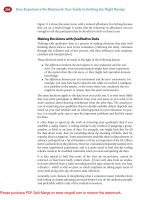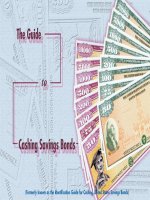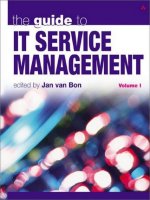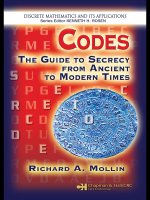The guide to minimum viable products
Bạn đang xem bản rút gọn của tài liệu. Xem và tải ngay bản đầy đủ của tài liệu tại đây (7.61 MB, 130 trang )
THE GUIDE TO
MINIMUM VIABLE PRODUCTS
A Master Collection of Frameworks, Expert Opinions, and Examples
INDEX
4Introduction
8
Minimum Viable Products -Defined by The Experts
9
What’s An MVP?
10
Experts’ Takes on MVPs
18
MVPs are an important means to an end
19
M in MVP: Expert Takes on Product Minimalism
21
Seize your unfair advantage quickly
23
Focus on the assumptions to avoid scope creep
26
Stay true to your product DNA
27
Keep it simple and experimental
29
The V in MVP: Expert Takes on Product Viability
30
Establishing and Sustaining Viability
32
Understanding Product vs. Business Viability
33
Determining Product Viability
34
Determining Business Viability
39
Have a method for the qualitative madness
41
Give your product a life of its own
42
P in MVP: Expert Takes on Product Quality
43
8 Dimensions of Product Quality
44
Play to Emotions — Delight Early Adopters
48
Add Logical Value — Help Them Do Something
51
Leverage Networks — Don’t Rely On Them
52
Quality Varies By MVP Purpose
53
Focus on a complete product instead of complete features
54
Balancing Product UX and Lean Execution
56
Competing Priorities: Experience vs. Execution
60
The Stages of Product Development
62
UX Design vs. Lean Design
64
Stay Lean — With Your Eye On UX
66
Top 15 Ways to Test Minimum Viable Product
67
Testing your MVP
85
Getting out the door
87
Building Minimum Viable Products at Spotify
89
Lean & Agile at Spotify
91
I. Think It
94
II. Build It
97
III. Ship It
98
IV. Tweak it
100 More Product Stages = Less Cost, Less Risk
102 4 Reasons Minimum Viable Products Fail
104 Systematically tackling 3 types of risk
106 How teams fail to address these risks
113
Stay Focused Or Your MVP Will SUX
114 10 Massively Successful Minimum Viable Products
115
1. Dropbox
117
2. Airbnb
118
3. Groupon
119 4. Buffer
121
123 6. Twitter
124 7. Zynga
125 8. Foursquare
126 9. Spotify
127 10. Pebble
128 Testing the Riskiest Assumptions
5. Zappos
k
is eboo
h
t
e
r
a
Sh
iends!
with fr
CHAPTER ONE
INTRODUCTION
A quick note from the author
Minimum viable products are frequently misunderstood and misused. Because
most business are strapped for resources, it’s a common mistake to focus only on
the “minimum” part to get something out the door quickly.
But an MVP is much more than just a minimum product. It is perfection by subtraction, the best bang for your buck, a serious reality check — “Hello, World!”. An
MVP trims all the fat and leaves just the essence of your value to customers with
the resources.
In this book, we’ll share a wide breadth of expert commentary, theories, practices, and real-life examples of MVP success and failure. To name a few, we’ve
included advice from entrepreneurs like Steve Blank, Eric Ries, Guy Kawasaki,
Ash Maurya, Andrew Chen, Cindy Alvarez, Rand Fishkin, David Aycan, Joel
Gascoigne, Josh Puckett, Brandon Schauer, Chrys Bader, Neil Patel, Nick Swinmurn, and more. We’ll discuss basic concepts like the different types of MVPs
and how to test hypotheses with MVPs. For more experienced readers, we’ve also
laid out how to apply MVP thinking in a Lean and Agile environment, how to balance UX with Lean development, and even Spotify’s internal design process. Our
hope is that it will help you better understand how to strike the perfect balance
between resource minimalism, business viability, and product quality in your next
MVP.
When you think about it, testing an MVP is probably the most important step
to success for companies. We’ll look at how highly successful companies like
Twitter, Zynga, Foursquare, Dropbox, Zappos, Groupon, Oculus VR, Airbnb,
Buffer, Pebble among others built the right MVP for the right reasons to help
them refine their business idea and get people buzzing about their products.
We’ve also included our own story and outlined how you can use UXPin to help
prototype your own MVP.
5
We’d love your thoughts on what we’ve written. And feel free to include anyone
else in the discussion by sharing this e-book.
For the love of minimum viable products,
Chris Bank
(co-written by Jerry Cao & Waleed Zuberi)
Chris Bank is the growth lead @UXPin. He also
led growth @Lettuce (acquired by Intuit),@MyFit
(acquired by Naviance), and his own startup @Epostmarks (USPS strategic partner), and launched @Kaggle in the B2B tech vertical. In his downtime, he rock
climbs, motorcycles, designs apps, travels, and reads.
Visit my website and Follow me on Twitter.
Jerry Cao is a content strategist at UXPin where he
gets to put his overly active imagination to paper
every day. In a past life, he developed content strategies for clients at Brafton and worked in traditional
advertising at DDB San Francisco. In his spare time he
enjoys playing electric guitar, watching foreign horror
films, and expanding his knowledge of random facts.
Follow me on Twitter.
6
Waleed Zuberi is passionate about creating better
user experiences through thoughtful design. When
he’s not writing or pushing pixels on the web, he
enjoys biking, playing cricket and binge-watching
TV. Visit his website and follow him on Twitter.
7
k
is eboo
h
t
e
r
a
Sh
iends!
with fr
CHAPTER TWO
MINIMUM VIABLE PRODUCTS
-DEFINED BY THE EXPERTS
How the top product minds in the world think about MVPs
8
Today, lean startups and tech titans alike are increasingly using the minimum
viable product (MVP) as a starting point for building successful software products.
By focusing on an integral set of key features and core functionality for product development, firms can efficiently establish a definitive core to form the
basis out of which the rest of the product can evolve. If they can’t get this right,
they risk ending up with a product that SUX — an offering with a “Sh***y User
Experience.”
Source: Lean Heroes
WHAT’S AN MVP?
Startups and tech titans alike use varying measures for defining what goes into
an MVP, and many are still slightly misguided.
A common misconception is that an MVP consists of the minimum set of features
deemed necessary for a working software product, with the goal of bringing it to
market quickly. This misses the mark on several levels, most notably in the overemphasis on speedy delivery and time to market, as opposed to focusing on
customer and market acceptance. Indeed, rapid development is of essence, but
only to the extent that learning and research objectives can be obtained quickly.
9
As defined by Wikipedia, “The minimum viable product (MVP) is a strategy used for
fast and quantitative market testing of a product or product feature. The term was
coined by Frank Robinson and popularized by Eric Ries for web applications.” This
definition is narrow — particularly, it’s too quantitative and product-focused —
according to many experts. However, some of the noted purposes of an MVP
below begin to open up a more significant discussion:
• Be able to test a product hypothesis with minimal resources
• Accelerate learning
• Reduce wasted engineering hours
• Get the product to early customers as soon as possible
Let’s look at what the experts have to have to say.
EXPERTS’ TAKES ON MVPS
It’s important for you and your team to form your own opinion about what an
MVP means to you, but hopefully the viewpoints of some notable executives
below help you flesh that out.
10
Sources: Eric, Ash, Nick, Steve, Rand, Cindy and Marcin
Eric Ries, cofounder/CTO of IMVU and MVP proponent, defines an MVP as
a version of a new product that allows for the most learning possible for the least
amount of effort. That is to say, an MVP allows for testing actual usage scenarios
with customers. To this end, expensive market research and subsequent product
development is eschewed; instead, a rapidly-built product with a minimum set of
features is deployed to test assumptions about customer requirements.
You’ve probably already heard this definition enough times to make you scream.
So let’s round this off with other helpful perspectives.
11
Source: Build Measure Learn
Ash Maurya, CEO of P2P sharing site Cloudfire and author of Running
Lean - Helping Entrepreneurs Succeed, recounts his experiences in building an
MVP for his startup. After identifying a target group of users, he then proceeded
to identify the three main issues they experienced with current solutions on the
market. He was then able to build a solution to minimally address those issues,
and drive early adopters to sign up via the product’s landing page. Fortunately for
Maurya, the process was simplified through leveraging key functionality from a
previous product. This allowed him to dramatically cut the time and effort it took
him to validate his assumptions about the potential user base for his product.
Reflecting on his experience, Ash now emphasizes the importance of capturing
customer value with any MVP. It’s critical to get the product right, so make sure
you have a problem worth solving. Using the Lean Canvas framework below, he
highlights the 4 critical steps to nailing the product in your MVP:
• First make sure you have a problem worth solving.
• Then define the smallest possible solution (MVP).
• Build and validate your MVP at small scale (demonstrate UVP).
12
• Then verify it at large scale.
• To understand market and customer risks of an MVP, see his post The 10x
Product Launch.
Source: The 10x Product Launch
Marcin Treder, CEO and Co-Founder of UXPin, went through a very similar
experience although his company’s existing product was a paper prototyping
notepad while the current solution is a web-based wireframing and prototyping application. “Clearly, the paper products were cheaper to make initially,” he
states, “But we honestly had no idea that our next version of the product would
be technical — we were a few designers just trying to help our peers become
better designers.”
13
“An MVP requires minimum development effort to create maximum value.”
But he quickly realized how fragmented the existing solutions were and how
much people complained about them.According to Treder, “An MVP isn’t the
quickest or the most perfect product. Rather, it is a product with minimum development effort that creates maximum value.” He admits that his first product
didn’t provide the maximum value given current alternatives today. But, today,
UXPin is one of the leading wireframing and prototyping applications on the market. So he clearly made the transition.
Source: Practical Product Management for New Product Managers
To get the most value out of development efforts, you can use the above matrix
to systematically prioritize features. Of course, not all lean startups will have
the luxury of having a pre-existing product to massage into MVP form. In many
cases, this is barely necessary.
Nick Swinmurn, Zappos co-founder, experienced this first-hand. In an
14
Share
Quote
extreme case of MVP leanness and agility, the e-commerce stalwart’s humble
beginnings started with Swinmurn photographing shoes at a local retailer. He
then posted the photos online and, for each online order, he would return to
the retailer and buy the necessary items. In this sense, the primary objective of
an MVP is to eliminate business uncertainty to the greatest extent possible. He
didn’t have a product and acted as his own customer in the initial stages.
Source: The 10x Product Launch
And it’s far more common for companies to sell and market vaporware (products
that don’t yet exist or barely exist) — especially in the startup world.
Cindy Alvarez, UX for Yammer and previously Product at Kissmetrics,
echoes that a common mistake people make is assuming an MVP needs to be
a product. According to her, the goal of an MVP is to maximize learning while
minimizing risk and investment and, therefore, a product should not be the only
means to that end. By thinking so narrowly about MVPs, she has seen many people start by thinking about the “final” product and trying to cut features instead of
doing anything scientific. To avoid this pitfall, one of her rules of thumb is following the Cupcake Model whereby you think of one complete experience.
15
Source: 7 Ways to Test MVPs
She also provides some practical advice in executing on MVPs within teams.
She claims there are two important problems that must be addressed head-on
internally:
1. Set expectations appropriately — No one wants to build something
crappy and feel that they will never get the chance to make it better. Emphasize that the purpose of MVPs is to make sure your team isn’t wasting its time
on worthless products and features and that your team can actually improve
the product using validated testing.
2. Set your MVP target customer appropriately — Be careful about building
for a mainstream audience. If you do, they may tell you it sucks and you’ll get
the wrong signals about what you’re building. Instead, find customers with an
identified early pain and show them your early, sloppy MVP that is supposed
to solve their problem.
Steve Blank, a serial-entrepreneur and author / lecturer on MVPs, asserts
that the Customer Development and Lean Startup methodology under-emphasizes the importance of selling a vision to visionaries — not everyone — while
delivering a minimum feature set. From his observations, many people easily
comprehend how to build a minimal product with few features (the Minimum
16
Feature Set), but they fail to acknowledge that most people won’t like their MVP
— how many people do you know will brag about a minimal product? Instead,
companies should be building early adoption and evangelism while selling a
vision about how the world will work, and be so much better, with the product
being built a few years out based on a minimal product that you can play around
with today.
5. Has or can
acquire a Budget
4. Has Put Together a Solution
out of Piece Parts
3. Has been Actively Looking
for a Solution
2. Is Aware of a having a Problem
1. Has a Problem
Source: Silicon Africa, 5 Characteristics of Earlyvangelists
Rand Fishkin, co-founder of Moz, seems to be more of a showman than the
rest. From his perspective, first impressions matter — a lot. It is for this reason
that he encourages others to take their MVP one step further toward being an
EVP (an Exceptional, Viable Product). He claims to have seen a lot of MVPs launch
that hardly produce significant value, and strongly believes it’s highly problematic. After all, there’s only so many times you can re-launch a product. In practice,
Rand suggests making your MVPs in-house and dogfooding them internally and
with a few customers. Gather feedback and iterate until the first internal and
external users find that “A Ha” moment, then release it to the wild as an EVP. This
17
may take an extra 30-90+ days to reach this point but, in his opinion, it’s well
worth the wait.
Source: Moz, “7 unlikely recommendations for startups & entrepreneurs”
MVPS ARE AN IMPORTANT MEANS TO AN END
There are many ways to skin a cat, but even more ways to deliver an MVP.
Although each expert has their own twist on what an MVP means to them and
the golden rules they follow to make sure they don’t get caught in the weeds, the
underlying message is the same: MVPs are a means to an end product or product
improvement, not the end product itself. Make sure you don’t lose sight of that.
18
k
is eboo
h
t
e
r
a
Sh
iends!
with fr
CHAPTER TWO
M IN MVP: EXPERT TAKES ON
PRODUCT MINIMALISM
How to think about constraints when building your next product
19
Applying minimalism is perhaps the most difficult but important part of the MVP
process. After all, your interpretation determines the strategy behind selecting
the right features and technical resources. Use the right amount of minimalism and you create an elegant gem that is low-cost and high-learning. Go overboard with trimming your features and you end up with a shoddy prototype that
doesn’t just fail at answering your hypotheses but could embarrass the brand.
Source: Stop Overthinking… Just Stop
So how do you build a stripped-down product that is affordable and appealing?
Start by understanding the difference between these 2 questions:
Question A: How can we build the simplest technically feasible product?
Question B: How can we build the simplest product to resonate with early
adopters?
The first approach prioritizes deliverability and can result in the mistake of using
a set of tires to test the concept of a car. The second approach focuses on the
core value of the product, a principle that is much more helpful towards uncovering the learnings you need.
Read on to hear expert advice on MVPs and how you can use minimalism to
develop a high-quality, focused experiment for your most important users.
20
SEIZE YOUR UNFAIR ADVANTAGE QUICKLY
When designing the UXPin MVP for the US market, we interviewed influencers
to gather feedback on what features and functionality were missing in today’s
UX tools. We bounced around ideas on product strategy and even sketched wireframes on napkins. We sought their advice to better understand the early adopter
mindset and prevent ourselves from releasing a “minimum product” that would
fail to convey our vision.
Former Apple chief evangelist, Guy Kawasaki, asserts in his MVP philosophy
that the MVP does not need to be perfect but it does need to be revolutionary.
The goal of minimalism then is to reduce engineering waste by only incorporating enough features that embody your unfair advantage to capture the interest
of early adopters. These “earlyvangelists” (coined by serial entrepreneur Steve
Blank) can make or break your idea, so focus your MVP on the soul of your product to best learn from these force-multipliers.
According to Matchist.com cofounder, Stella Fayman, in a piece on MVPs for
KISSMetrics, balance these 3 questions to stay on track:
• Are resources dedicated to simplifying the MVP?
• Are the assumptions focused just on the core value?
• Is my timeline as lean as possible?
Focusing on question #2 above is extremely important for anchoring your minimalistic approach in customer reality. As Fayman suggests, start by mapping your
functionalities to assumptions and add more layers of functionality into your
MVP only as you prove each assumption. This ensures that no matter the depth
of your feature set, you’re always executing them properly for a consistent early
21
adopter experience.
It can be hard to understand minimalism abstractly, so let’s look at a real-world
example below.
Source: Sell It Before You Build It
At Fliggo (merged with Vidly), Chrys Bader, currently the co-founder and
Chief Product Officer at Secret, wanted to test the assumption that users
would find value in being able to host their own video-streaming site, which at
the time could only be easily accomplished by creating a Wordpress site and
embedding via Youtube. Just the right amount of minimalism was applied above
to create an MVP that allowed Fliggo to not only test if early adopters would sign
up, but also if they were willing to pay.
If demand for the product vision was verified (which it was in this case), the next
iteration of the MVP could test pricing by increasing or decreasing the monthly
fee on the landing page. Such a tweak would be minimalistic by not disrupting
the simple interaction of filling out the form while still focusing the learning even
further.
While it’s cheap and simple, a landing page is not a one-size-fits-all MVP. Startup
22
advisor and founder of Extreme Lean TV, Ramli John, warns against taking a
uniform approach to MVPs. Relying solely on landing pages is dangerous because
you might not able to gather feedback from early adopters who sign up (What
are their problems? What would they like to pay?) and lack of signups might not
be due to the product itself (perhaps the copy is poor or design is distracting).
Ramli advises other low-cost, high-feedback MVPs such as email, blogs, and
video. In fact, as Ramli points out, popular startup and investor matchmaker
AngelList tested its networking value by emailing introductions between startups
seeking funding and active investors — validating its business hypothesis while
still providing a pleasant early adopter experience. By simplifying down to just its
unfair advantage, AngelList created the right MVP.
FOCUS ON THE ASSUMPTIONS TO AVOID SCOPE
CREEP
An important aspect of MVP minimalism is the time dedicated to development,
as this is as precious a resource as money or manpower. Although projects often
experience scope creep, this is arguably one of the most comprehensible aspects
of designing and developing MVPs.
In UXPin, our team collaborates on deciding the amount of time required to complete
certain aspects of the product design. Once we finalize the design and compile our
comments from UXPin, we can plan out the time to production in more detail in a
project management tool like Asana or JIRA.
23
Source: The Wrong Stuff vs. Stuff With Errors
So how long is too long to spend on developing an MVP? Rick Screnta, creator
of the search engine Blekko, maintains that it depends on the product. For
some web applications like Fliggo, a simple landing page was enough. For offerings with higher expectations and greater coverage and attention, MVP development can and probably should take longer to avoid negative user backlash that
arise from an overly simplistic or poorly built product. He cites his company’s
search engine, which required 3 years for an MVP, as a primary example of this
assertion.
A more relevant inquiry may be what to build, as opposed to how long—as the
answer to the former question invariably answers the latter. In the illustration
from Signal vs. Noise below, Ryan Singer, a Product Manager at Basecamp,
suggests that minimalism in MVP scope is achieved by maintaining a base quality
of execution and adjusting the number of features accordingly.
24
Source: What Happens to User Experience in a Minimum Viable Product
KISSMetrics founder, Neil Patel, cites some interesting examples of some
notable humble MVP beginnings of varying scope but consistent execution:
• Dropbox — started with a 3 minute video for their MVP, resulting in signups
increasing from 5,000 people to 75,000 overnight—all of this in absence of a
real product
• Foursquare — started from collecting customer feedback using Google Docs
• Virgin Air — began with one plane and one route to validate their assumptions, with more planes and routes added as they refined their business
• Groupon — started as a WordPress blog with a widget that sent PDF coupons
via email
Virgin’s MVP was the most resource-intensive, while Foursquare’s MVP was the
most lightweight. However, each MVP was only as complex as the assumptions it
sought to test. More importantly, you’ll notice that each MVP wasn’t over simplified to where the value proposition and early adopter experience were sacrificed.
Present-day Groupon, for example, still delivers on the value of its MVP by con25









